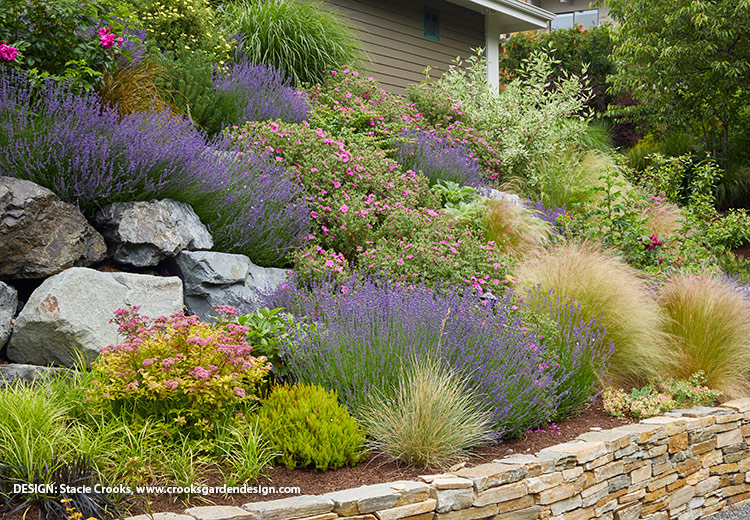
So many reasons to love different types of lavender!
Lavender is such an amazing plant. It blooms for weeks in summer, doesn't need a lot of maintenance, brings in bees and butterflies but deters deer, makes a great addition to recipes and, of course, smells fantastic! The flowers, stems and foliage are loaded with oils that may occasionally waft through the garden on a warm breeze. But you’ll get the most intense experience by running your hands through the stems to release the aromatic oils. You can even use it to for this easy-to-make sugar scrub.
Growing lavender
There are about 30 species of lavender and hundreds of cultivars. While you might think of it as a perennial, lavender is actually a subshrub, which means it develops a woody base as it ages, but its long foliage-covered stems die back in cold winters.
Keep lavender healthy
Lavender grows best in well-drained soil and full sun. Plants are drought-tolerant but if it's been really dry in your area, provide some extra water on a regular basis. Drought stress can inhibit oil production so the foliage won't be as fragrant. Lavender does need pruning in order to keep a tidy habit and flower well. Follow our helpful guide to find out how. Harvest stems for your projects when blooms are just starting to open.
Add fragrance to your garden with lavender
All lavenders are fragrant, but some cultivars have a higher concentration of oils in the foliage, which makes the aroma more pronounced. Soil and weather can affect oil production, too. Most flowers are shades of purple, but there are also pink or white blooms. Let’s meet a few species and their cultivars.
You Might Also Like:
Tips for Growing a Fragrant Garden
5 Easy Herbs to Grow
Cottage Garden Charm
Which type of lavender will you grow?
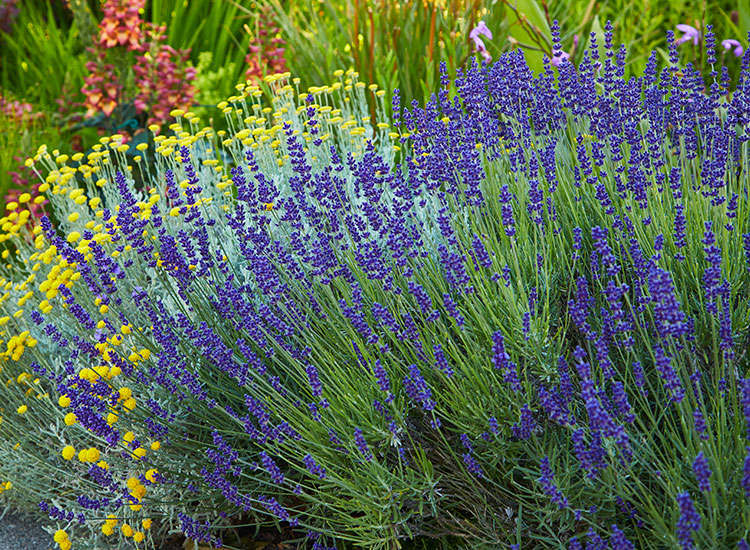
English lavender Lavandula angustifolia
This is the classic lavender. It has a strong, sweet scent and long stems that are topped by lavender to deep purple flowers. Deadheading encourages many cultivars to have a light rebloom. English lavender is used in cooking, crafts and dried arrangements. Stick with varieties that have deep purple blooms for drying — they hold their color longer and look better than the pink- or white-flowering varieties.
English lavender is one of the cold-hardiest and easiest to find in garden centers. ‘Hidcote’ in the photo above has been around a long time — those deep purple blooms show you why. It grows 2 to 3 feet tall and wide. Petite Sweet Romance® grows just 12 to 18 inches tall and wide and also has purple blooms. Grow it in a container on the steps to enjoy as you walk by. If you want to mix things up a bit, grow ‘Miss Katherine’ English lavender which has pale pink blooms and grows 15 to 18 inches tall.
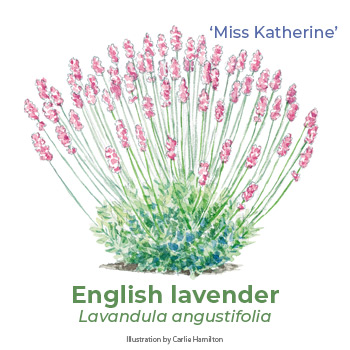
Blooms Purple, blue, pink or white in late spring to early summer
Size 1 to 4 ft. tall, 1 to 5 ft. wide
Hardiness Cold hardy in USDA zones 5 to 9
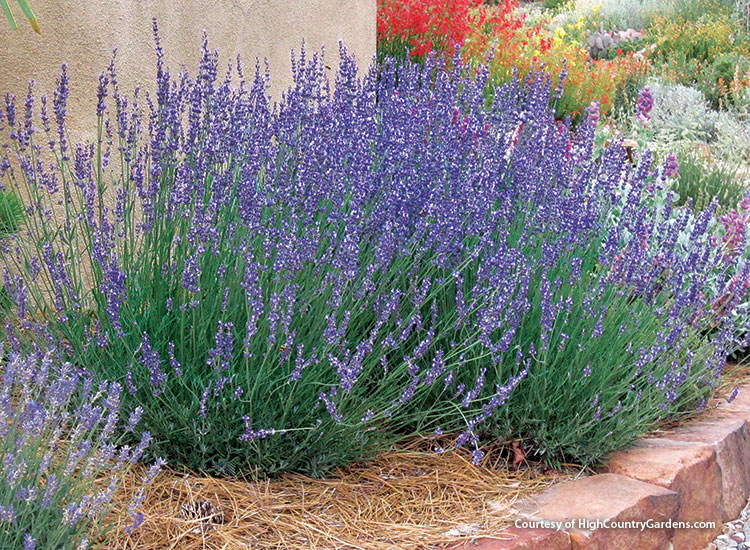
Lavandin Lavandula x intermedia
Lavandin is a cross between the two species L. angustifolia and L. latifolia with a more camphorlike scent than English lavender. It’s known for its long, strong stems (some can get up to 2 feet long) and high oil content. That gives it lots of fragrance — perfect for lavender wands, dried arrangements or projects, such as soap.
Those long, slender stems give lavandin a grasslike appearance that’s easy to work into any perennial border. Compact ‘Gros Bleu’ is a tried-and-true variety that grows 24 to 30 inches tall and wide. For a taller plant with a strong fragrance, try ‘Provence’ that grows 2 to 3 feet tall and wide. Phenomenal® is getting rave reviews for cold-hardiness, returning reliably in USDA zone 5. It also has good resistance to fungal disease, which can cause problems for many types of lavender in humid climates.

Blooms Shades of purple or white in midsummer
Size 2 to 5 ft. tall, 2 to 6 ft. wide
Hardiness Cold hardy USDA zones 5 to 8
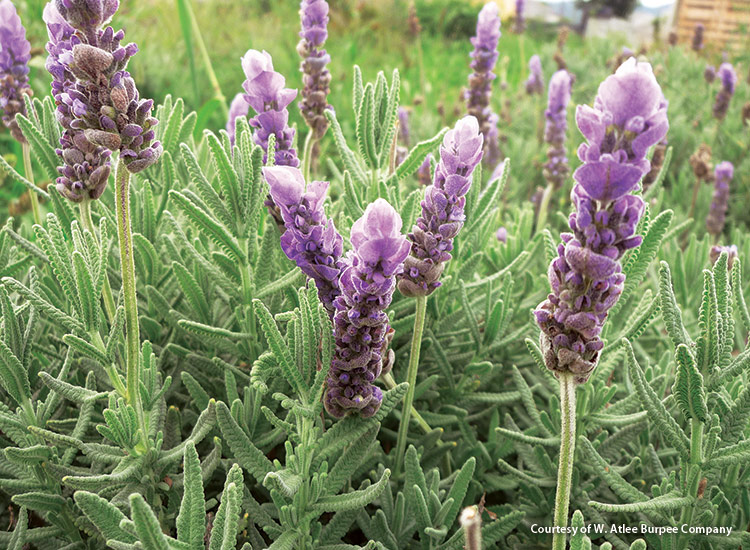
French lavender Lavandula dentata
The silver-gray, toothed foliage of French lavender looks like it’s been trimmed with pinking shears. It has a sweet scent good for use in sachets, potpourri and other crafts. It's not usually used in cooking. The big lavender blooms start in late spring and keep on going until fall.
This species is more tolerant of humidity than English lavender but it isn’t very cold-hardy. Where it’s not hardy, grow petite varieties, such as 12- to 14-inch-tall-and-wide Evermore Blue, in a container on the patio where you can enjoy those pretty leaves and its lovely fragrance. Most French lavenders have green foliage, but ‘Linda Ligon’ has irregular cream variegation.
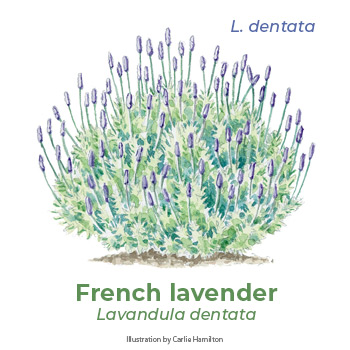
Blooms Purple in late spring to summer
Size 2 to 4 ft. tall, 2 to 3 ft. wide
Cold hardiness Cold hardy in USDA zones 9 to 10
You Might Also Like:
Fragrant Flowers for Your Garden
Deer Resistant Plants
Edible Flowers
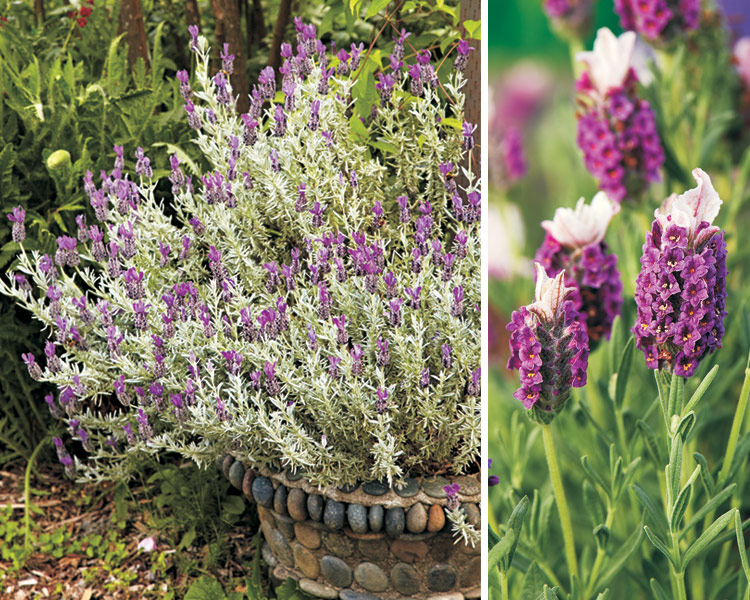
Spanish lavender Lavandula stoechas
You can’t miss the distinctive blooms of Spanish lavender — they look like they could fly right off the stem. The little “flag” on top is a bract, a small leaflike structure, that varies in length, depending on the cultivar. The species, above left, flowers purple. Cultivar Bandera Pink (above, right) grows just 7 to 9 inches tall and 10 to 12 inches wide. It’s a good candidate for any spot where you need a drought tolerant front of-the-border plant. You can also find white-flowering Lavela Compact White which grows 13 to 15 inches tall and 10 to 12 inches wide. Once that first flush of blooms is done, remove the spent blossoms for a second showing. For a showy flower grow ‘Anouk’ that has deep purple blooms and a mauve flag. It grows 24 to 30 inches tall and wide.
Where summers are humid, Spanish lavender is the best choice. It tolerates muggy conditions without fungal disease ruining its good-looking silver-gray foliage.
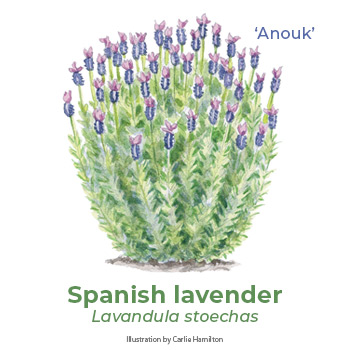
Blooms Purple, pink or white in spring to summer
Size 1 to 4 ft. tall, 1 to 5 ft. wide
Hardiness Cold hardy in USDA zones 8 to 11
















